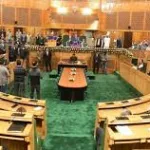What is Autism?
Autism spectrum disorder (ASD) is a neurobiological disorder with onset in early childhood. The key features are impairment in social communication and social interaction accompanied by restricted and repetitive behaviours. The presentation of ASD can vary significantly from one individual to another, as well as over the course of development for a particular child. Accurate diagnosis requires careful review of the history and direct observation of the child’s behaviour.
How common is Autism?
The prevalence of ASD is estimated at 1 in 50-65 persons. The prevalence increased significantly over the past 25 years, primarily because of improved diagnosis and case finding as well as inclusion of less severe presentations within the autism spectrum. Autism however continues to be underdiagnosed in developing setups including Kashmir.The purpose of this article is to highlight the same and sensitise parents towards early recognition of symptoms and medical contact. There is a 4:1 male predominance.The prevalence is increased in siblings and particularly in identical twins. There are no racial or ethnic differences in prevalence. Individuals from racial minorities and lower socioeconomic status are at risk for later diagnosis.
What are the symptoms/features of Autism?
Symptoms can present early in infancy, with reduced response to name and unusual use of objects being strong predictors for risk of ASD. Individuals with milder severity may not present until preschool or school age, when the social demands for peer interaction and group participation are higher. Three core features include:
- Social Communication and Social Interaction
Individuals with ASD have difficulty understanding and engaging in social relationships. The problems are pervasive and impact 3 major areas: reciprocal social interactions, nonverbal communication, and understanding of social relationships.The presentation can vary with severity and developmental functioning.Diagnosis of ASD requires the presence of symptoms from all 3 categories.
- Social-Emotional Reciprocity
Reduced social interactions in ASD may range from active avoidance or reduced social response to having an interest in, but lacking ability to initiate or sustain an interaction with peers or adults. A young child with ASD may not respond when his name is called, may exhibit limited showing and sharing behaviours, and may prefer solitary play. In addition, the child may avoid attempts by others to play and may not participate in activities that require taking turns, such as peek-a-boo and ball play.
An older child with ASD may have an interest in peers but may not know how to initiate or join in play. The child may have trouble with the rules of conversation and may either talk at length about an area of interest or abruptly exit the interaction. Younger children often have limited capacity for imaginative or pretend play skills. Older children may engage in play but lack flexibility and may be highly directive to peers. Some children with ASD interact well with adults but struggle to interact with same-age peers.
- Nonverbal Communicative Behaviour
Difficulties with nonverbal communication may manifest as reduced use of eye contact and gestures such as pointing. Children may also show reduced awareness or response to the eye gaze or pointing of others. They may use eye contact only when communicating a highly preferred request or may have difficulty coordinating the use of nonverbal with verbal communication. Children with ASD may have limited range of facial expression or expressed emotion.
Developing, Maintaining, and Understanding Relationships
Children with ASD have limited insight regarding social relationships. They have difficulty understanding the difference between a true friend and a casual acquaintance. They have trouble picking up on the nuances of social interactions and understanding social expectations for polite behaviour. They may have reduced understanding of personal boundaries and may stand too close to others. In addition, they can have trouble understanding and inferring others’ emotions and are less likely to share emotion or enjoyment with others. Adolescents and young adults have difficulty engaging in group interactions and navigating romantic relationships.
Restrictive and Repetitive Behaviour
Stereotyped Motor Movements or Speech: Stereotyped (or stereotypic) movements and repetitive behaviours may include hand flapping, finger movements, body rocking and lunging, jumping, running and spinning, and repetitive speech such as echoing words immediately after they are said. Repetitive patterns of play may be present, such as lining up objects, repetitively turning light switches on and off or opening and closing doors, spinning objects, or arranging toys in a specific manner. These repetitive patterns may not be seen in very young toddlers but may develop as they get older. Stereotyped movements can change over time and in older children are seen more often in individuals with lower cognitive functioning.
Insistence on Sameness
Children with ASD have difficulty tolerating transitions or change. Intolerance for change causes significant impairment and impact on child and family function.
Restricted Interests
This symptom may manifest as intense interests that seem out of the norm in comparison to same-age peers. Younger children may play with a limited range of toys or may insist on retaining a small object in each hand. Older children may have a strong preference for a particular story or movie. Otheraffected children may have interests that are both intense and odd, suchas an interest in brands of vehicles, fans and heating systems. These interests interfere with social interactions; a child may only want to talk about her area of interest or may insist that peers act out a particular story in a rigid and inflexible manner.
Hypo- or Hyper-reactivity to Sensory Input
Children with ASD may be overly sensitive to sensory input, such as noise, smells, or texture. Children may scream when they hear a siren or vacuum and may gag and choke with certain foods or odours. They may refuse to wear certain clothing or may become very distressed with bathing or with cutting nails and hair. Conversely, some affected children seem to crave sensory input. They may engage in repetitive jumping or hugging and may smell or lick objects or people. Young children may inappropriately touch the face or hair of others.
Causes
The aetiology of ASD is thought to result from disrupted neural connectivity and is primarily impacted by genetic variations affecting early brain development. There is also evidence for environmental contributions to ASD. Older maternal or paternal age may increase the risk of ASD. In addition, factors influencing the intrauterine environment, such as maternal obesity or overweight, short interval from prior pregnancy, premature birth, and certain pregnancy related infections are associated with ASD. Despite frequent concerns from families that vaccines or the preservatives in vaccines lead to ASD, there is no evidence to support this claim. Many conditions mimic ASD. And some of these may coexist with ASD. The most important conditionsto consider in young children are language disorder, intellectual disability or global developmental delay,and hearing loss,socialcommunication disorder,disorders of attention, learning, and mood regulation, social anxiety or other anxiety disorders, reactive attachment disorder, obsessive-compulsive disorder, tics, and stereotyped.
Conditions Associated With Autism
Up to 50% of individuals with ASD have intellectual disability, ranging in severity from mild to severe. Children with ASD often have associated language impairments, including delays in expressive, receptive, and pragmatic language skills. Language function can range widely from nonverbal status to age appropriate. Gastrointestinal problems such as constipation, esophagitis, and gastroesophageal reflux disease are reported in up to 70% of children with ASD. Epilepsy occurs in up to 35% of children with ASD and presents in 2 peaks, in early childhood and in adolescence. Children with ASD are at higher risk for disorders of attention, including reduced attention for non preferred activities and excessive attention for preferred activities. There are higher rates of anxiety (~40%) and mood disorders in ASD, particularly during adolescence.
Children with ASD are also at increased risk for being bullied and may present with secondary irritability, anxiety, or depression. Sleep problems, including delayed sleep onset, frequent night waking, and abnormal sleep architecture, are reported in 50–80% of children with ASD. Children with ASD also have higher rates of feeding and toileting problems resulting from resistance to change, sensory sensitivity, and repetitive behaviour patterns.
Many children with ASD have restrictive feeding patterns and food selectivity. They also have higher rates of overweight, possibly because of diets higher in carbohydrates, reduced physical activity, use of food rewards to regulate behaviour, and side effects from medications used for managing mood and behaviour. Disruptive behaviours such as self-injury and aggression are common in ASD patients, but most common in individuals with lower cognitive function and limited language. Sleep deprivation, nutritional deficits, pain, epilepsy, and medication side effects may contribute to disruptive behaviours.
Treatment and Management
The primary treatment for ASD is done outside the medical setting and includes developmental and educational programming. Numerous resources have been developed that can help families in the complex process of treatment planning. Additional medical or behavioural health treatment is often required for management of co-occurring conditions in ASD.
Autism Resources for Families
- Autism Speaks First 100 Days kit.
- https://www.autismspeaks.org/family-services/tool-kits/100-day-kit.
- Autism Speaks Toolkits–dental, transition, guardianship.
- https://www.autismspeaks.org/family-services/tool-kits.
Outcome
Autism spectrum disorder is a lifelong condition. Although a minority of individuals respond so well to therapy that they no longer meet criteria for the diagnosis, most will make progress but continue to have some impairment in social and behavioural function as adults. Adult outcome studies are sobering, indicating that many adults with ASD are socially isolated, lack gainful employment or independent living, and have higher rates of depression and anxiety. It is not clear if these data can be extrapolated to younger children currently receiving intensive educational therapies.
(Author is MBBS, DCH DNB Pediatrics. Feedback: [email protected])





